This story began for me in 2015, when I watched a YouTube program with Pavel Polyan on the 70th anniversary of the liberation of Auschwitz-Birkenau. He spoke about his book Scrolls from the Ashes, his new translations from original documents from direct witnesses of the Holocaust -
members of Sondercommando , about the places he found censored by the first translators, about the state of manuscripts and the technical problems of reading that he encountered.
I was interested in the moment: how does the process of translation of military documents look like, how well they were digitized, everything was done in order not to break the eyes of the translator. When I received a copy of digitized documents for analysis, I was surprised by the undiscovered potential of one of them - Marcel Najari. Its part in the "scrolls of the ashes" occupied a very small chapter, a few years later this story was unwound before publications in the world media. She is as interesting as scary.
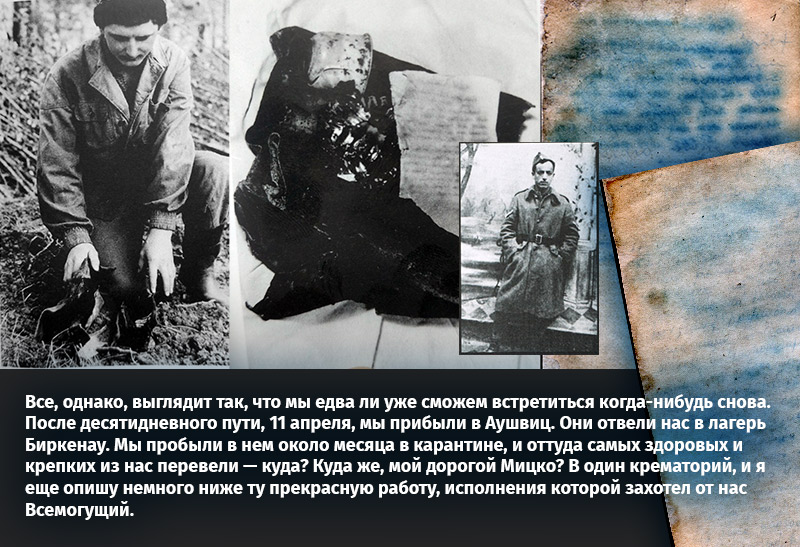
Prehistory
On April 2, 1944, in Athens, Marcel Najari, together with a group of other Greek Jews, was pushed into a carriage going in an unknown direction. Previously hijacked parents and sister could be at the end of the route, so Marcel, although being a partisan, still did not want to escape from the train.
Marcel NajariA few days later, the carriage arrived and having passed the selection on the ramp in Auschwitz-Birkenau and the monthly quarantine of Marseille was enrolled in Sonderkommando. This is a special team in which CC-oats chose physically resilient and stress-resistant, since this work required special efforts: escorting people who did not go through the gas chambers of the people from the trains, cutting hair, removing golden crowns, burning corpses, disposing of ashes, cleaning the gas chamber. Even when, on pain of death, people were told the truth about the "shower", they were unable to believe it. But some knew they were going to die and asked only to tell the truth about what was going on. (According to the testimony of another member of the Sondercommando Zalman Gradovsky, sometimes people chanted the Internationale (enemy anthem) inside the gas chamber until the filling of gas pellets with cyclone B, causing wild terror among the guards. Zalman Gradovsky died during the uprising on October 7, 1944, when 4- Crematorium. His diary was also found in a jar in the ground and is located in the Military Medical Museum in St. Petersburg, translated from Yiddish available in the book of Paul)
Meeting with friends and relatives from the trains, many of the Sonderkommando, being unable to tell the truth about this terrible place, passed with them inside the gas chamber.
Marcel was assigned to the crematorium number III and everything he encountered every day, plunged him into incredible horror and the question of the existence of a god who admitted it.
In February of this year, I was invited to a two-day conference in Berlin, half of which was dedicated to this manuscript. Among informal conversations with historians and professors at the end of the conference in someone's conversation at dinner, it was told that not everything that happened there was in open publications. The topic of sexual relations is still closed. There are sides that do not tolerate and paper with living offspring. Or the fact that the Gabay brothers, after their release, went to the mafia, kept a brothel and traded in weapons, if I remember the details correctly, they were absolutely fearless, for so much they did not care. 15 muffle crematorium №3
15 muffle crematorium №3The choice was very simple, either you obey orders, or you go along with the victims to the cell. But Marcel moved the hope of revenge, as he had long guessed that his mother and father and sister did not go through selection.
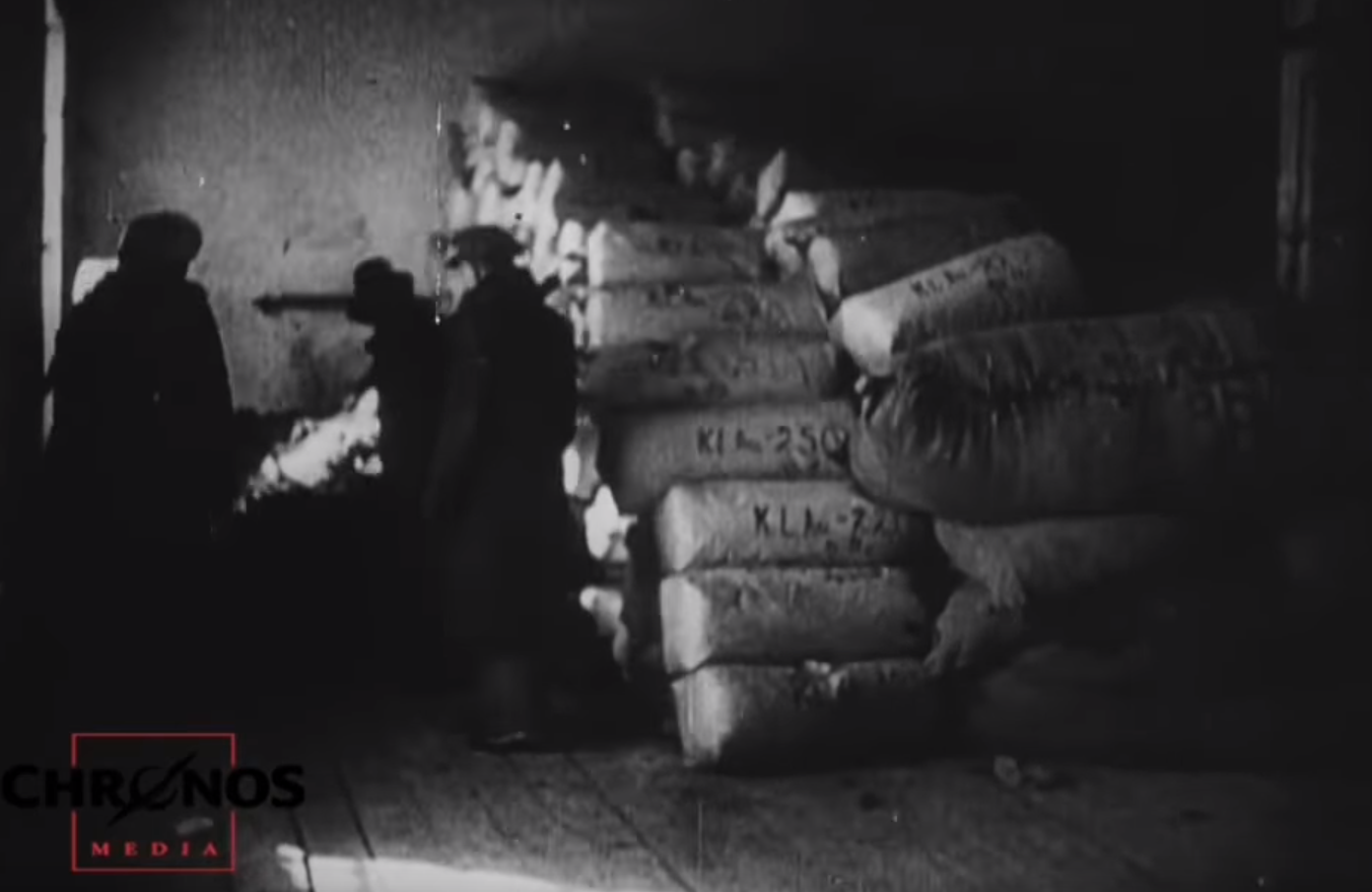 The Soviet commission on inspection of the hair stock together with the burgomaster of Auschwitz. On one of the bags the inscription KL. Au No. 250 22kg. (from the movie Befreiung von Auschwitz.)
The Soviet commission on inspection of the hair stock together with the burgomaster of Auschwitz. On one of the bags the inscription KL. Au No. 250 22kg. (from the movie Befreiung von Auschwitz.)Surviving the Sondercommando was a miracle. When it became clear to the camp command that Auschwitz-Birkenau had to leave, orders were given to destroy both crematoria and direct witnesses of what was happening. The staff cleansing took place with sophisticated lies, because how can you deceive those who know how you are fooling tens of thousands of people. "Relocation", "reassignment", "help beyond the camp" - any order that shared a brigade could have been hidden death. For all the time the concentration camp of the 2000 members of the Sonderkommando survived, about 100 survived and then by chance. Marcel, apparently, chose the right moment and, without responding to his number on roll calls, ran into a convoy of ordinary prisoners heading for another concentration camp.
April 15, 1947 - this date is set at the beginning of personal memories, written after release. In 1957, his daughter Nelly was born. According to her, her father was often tormented by nightmares, the cause of which he promised to tell when she would be 18 years old. But he died before the age of 54, when Nellie was only 14.
Manuscript
After 9 years, on October 24, 1980, while cleaning the area near the ruins of the former third crematorium at a depth of about 30 cm, a student of the local technical school found a glass flask from a thermos closed with a plastic stopper.
 Source: auschwitz.org
Source: auschwitz.orgInside there were 12 pages, for 35 years their condition has deteriorated greatly. Some of them were read, and the find was immediately accepted at the Auschwitz-Birkenau State Museum in Auschwitz.
Somewhere in the middle or at the end of the 90s, the manuscript was scanned by the museum, and in 2015 I asked Paul to send me all the scans from which he did translations for his book Scrolls from Ashes (this book contains translations of all famous manuscripts Sonder , not only Marcel). Since I worked a lot with digital images, I decided to see whether something can be extracted from them additionally. A quick look at the RGB channels showed that the manuscript of Marcel was the best to be read. In addition, it has an enormous role as the last document found and not refuted by the Holocaust. This is really good luck. The reasons for which every meter is not plowed near the crematoria are unclear (the reasons are certainly more political, but after 70 years it could be cool), because according to the evidence of these graves there were more. Even if something is found at the moment, it will most likely be unreadable.
 Scanned manuscript
Scanned manuscriptSince we did not have direct access to the originals, I was still interested in the technology itself, thanks to which manuscripts can be read on special equipment. And I needed some kind of theoretical base to understand why the scanned files contain information that is not visible in a color image. How to approach the treatment of the mind, and not in the forehead.
I will not go into all the well-known technologies for today, I will run only on the main ones.
X-ray tomography with phase contrast (see manuscripts from Herculaneum, the contrast is not found in the difference between ink and paper, as it is a charred papyrus, but in thickness! 100 microns is the height of the text relative to the paper).
X -
ray - was used for reading Archimedes' palimpsest (the text containing iron in ink was filled with rogues with a fake icon to increase the cost of publishing on the black market. A new passage was found to appeal to Aristotle, if memory serves).
Multispectral analysis - David Livingstone manuscript. The most popular and affordable technology today. In Africa, a researcher ran out of ink and he kept his notes on a newspaper using the juice of a local berry as ink. Multispectral analysis allowed in the UV range to raise the contrast of the juice of the berry in relation to the newspaper, and the mask from the IR range was used to remove typographic newspaper font. The diary is fully translated and available online. It contains information about the slaughter of the local population by slave traders in Zanzibar.
The whole theory for reading manuscripts is reduced to finding the contrast between the paper and the form of presenting information (ink). And this contrast can be detected if one is able to record the passage of electromagnetic waves either through (tomography and X-ray, gigahertz waves), or in reflection (multispectral analysis, luminescence) in different frequency ranges.
As soon as science manages to form images in any e / m range, we immediately make a scientific breakthrough in many areas. Since a breakthrough in the formation of images in the visible spectrum and near IR was made quite a long time ago (film, and now digital photosensors), this technology is now the most accessible and very efficient. She received the name "multispectral analysis." Its essence lies in shooting the manuscript at 12 (7 visible and 5 IR) wavelengths. From UV to IR. As a result, we can observe 12 layers, which contain different contrast between their components.
Here is an example of shooting the Qumran Manuscript in Israel (GIF animation).
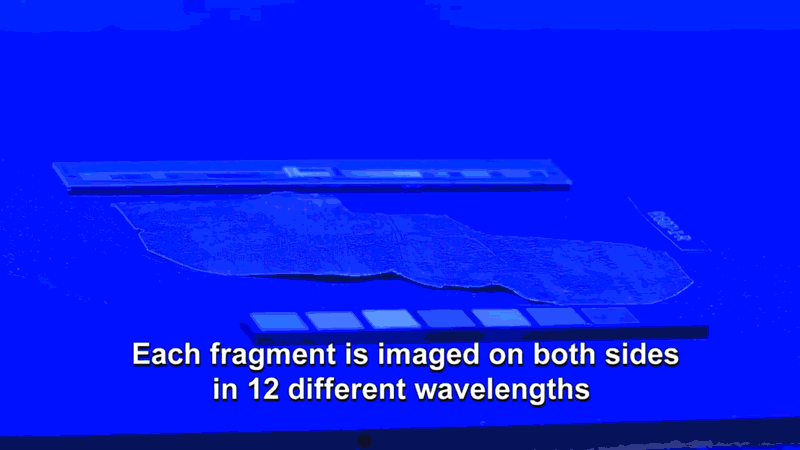
The color flatbed scanner provides only 3 layers - red, green and blue. When forming a color image on the monitors for our view, this is quite enough. After all, the shades of the eyes form, reacting not only to the wavelength, but also to the intensity of the three basic colors. In other words, the scanner also does multispectral analysis, but only at 3 wavelengths instead of 12. If you look at the CCD sensor datasheets (Color Linear Image Sensor), you will see three color bars (this is an RGB filter) in front of the sensor itself.
Talk about re-filming a manuscript on professional equipment in the museum is still dragging its feet even after a direct appeal from Marcel's daughter with a proposal to use her equipment, alas.
Looking for opportunities and learning technologies
Before starting the project, I had to completely plunge into the existing solutions, which I wrote about above. As if I had direct access to the manuscript. I studied the description of the technology, the equipment used, its cost, the description of the software and the work process.
There were attempts by Paul to appeal for help to the press service of the Ministry of Defense - the result is 0. They did not even answer.
I was looking for advice via the Internet, on the forums in the section of criminology. I know that they use spectral comparators to check documents, but there was no increase in special knowledge.
Then I climbed to the programmers, here on Habré, the authors of the software associated with image processing, and also realized that they couldn’t help me in this, (they suggested perhaps something necessary according to the theory of light, finally understood how the eye sees shades) and since there are no developments on this topic. I already knew about the list of available filters, just look at GIMP or imageJ or matlab help.
Next, I got involved in a correspondence with Antonino (
twitter.com/antoninocose ), the author of an open project on multispectral imaging. I received several consultations on equipment from him, gave me a couple of my publications to read, and this business sucked me slowly, and I decided to put together one such multispectral installation with 50W LEDs for experiments. The Chinese ordered LEDs on the list with different wavelengths, power supply, domestic radiator and radio control.

As a camera, I decided to play around with a smartphone, I ordered five additional cameras for it and try to scrape off the bayer pattern from it, removing the IR filter additionally.
Every time I opened the camera, I broke it. Later, I discovered that I simply did not see the wires that I cut off.
 The near camera is a sensor with an erased bayer pattern and a remote infrared filter.
The near camera is a sensor with an erased bayer pattern and a remote infrared filter.In general, twisted and turned. I tested the system on ordinary cameras. Works. Calmed down. On the astrocamera for $ 1000 with active cooling, I decided not to go broke.
Having gained some theory, I returned to the color scans of the manuscript.
Digital processing
So, take the first page of the manuscript. If we consider its RGB image, these are three half-tone images in which there is a different contrast between ink and paper.
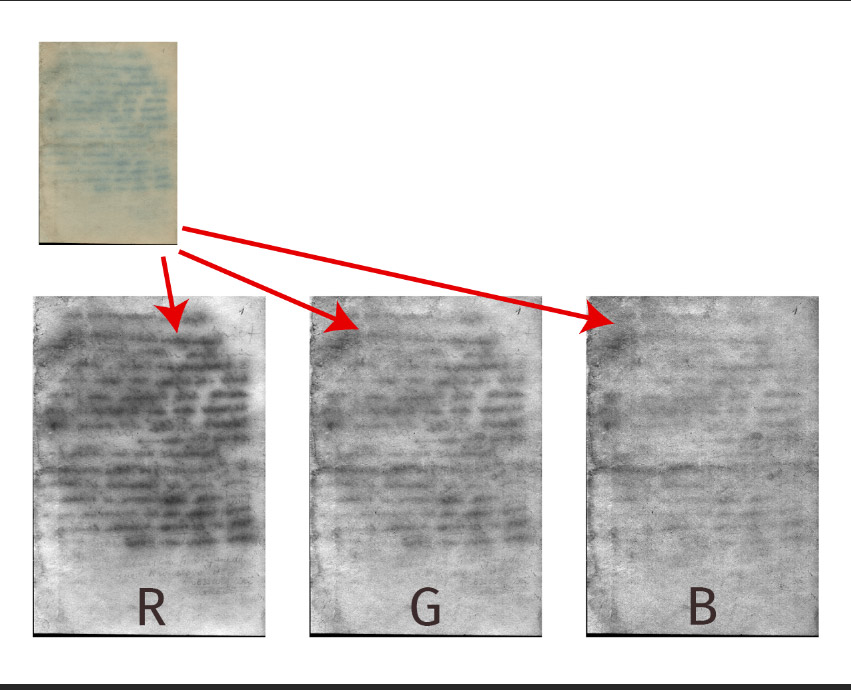
I will not show you enlarged fragments, the text is seen poorly on such a scale, but the text on the left in the red channel is the most legible. In the green in the center is worse. And in the latter - blue, it is visually absent.
Theory of multispectral analysis states that the more images are made at different wavelengths, the more likely it is to detect the required contrast. The RGB model is based on reproducing colors from the entire visible range. Therefore, theoretically, it was necessary to see what happens to the manuscript if you recalculate the RGB in 7 separate color layers.
For this task came Photoshop filter Black & White. Unfortunately, I haven’t found any analogues in other programs, which is why there are minor difficulties in scientific publications that use closed source software.
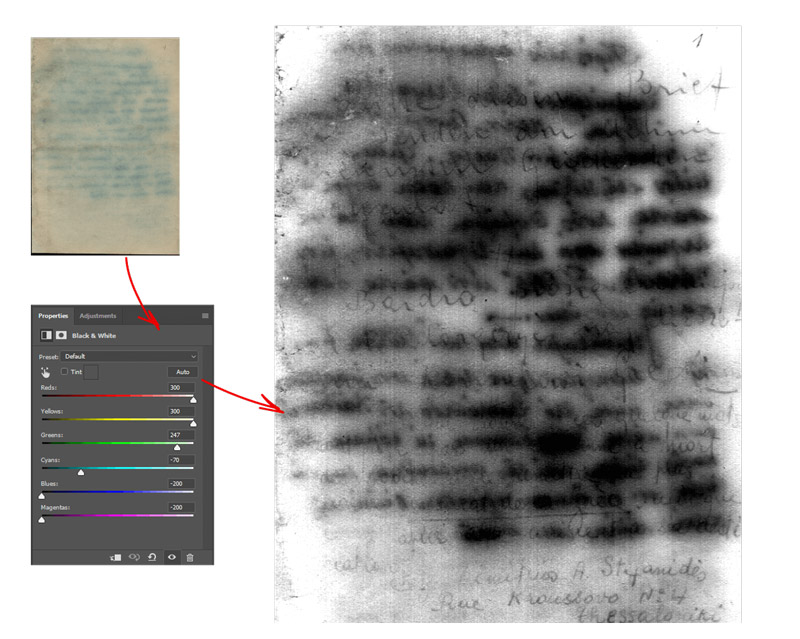
Filter parameters are shown in the picture above. I deliberately miss a moment in the constant use of the Curve filter, as this is too obvious. As a result, at this step, the readability of the text, though increased significantly: individual words became better visible, but too dark and too bright areas interfere with us. To eliminate these artifacts, we apply the HighPass filter as it was designed just to compress the brightness component of the signal.

It's funny now wonder the simplicity of the process. In the beginning, I tried a variety of approaches with a channel mixer, converting color spaces. How many were initially twisted-twisted, but following the theory and logic of analysis, this set of filters remained the most effective.
But something jarred me, some kind of nekonechnost. You look at these images and you suffer. Something else can be done, but what?
And in a couple of weeks it finally reaches me: Marcel kept a diary on two pages of one sheet and dark spots are artifacts of leaked ink. Of course! How could this not be noticed before. It is they who see for themselves.

The first page is on the left and the second is in the mirror image on the right. It can be seen that this is the same sheet.
Ink leakage compensation
If we have a sample with noise and noise separately, we can create a mask that compensates for it.
To do this, we need to very accurately combine the two images. You need to understand that the scanner device is mechanical, and each time you scan the same sheet, it can stretch it or compress it. Therefore, the imposition of two images should be carried out with fitting not only the angle but also the scale in a very small value. Oriented accounted for cross-cutting artifacts at the sheet. This task turned out to be quite difficult, it required pixel precision, which I did not immediately succeed.

After I have precisely combined the sheet and its reverse side, the following trick is required:
- Invert the colors of the overlay (reverse page, which lies on the top layer)
- To simulate the natural moisture blur of the ink filter Gaussan Blur with HighPass to "taste."
(Gaussian Blur should sometimes be replaced with Surface Blur, because it does not “ring” at the edges of the document. But since it is much more voracious, it is inconvenient for experiments.) - Set the transparency of this layer to 50%

After that, the image looks flat because we put our noise in antiphase. But if we now apply the Black & White filter to this, the result will be as follows:

This is a completely different matter. A further step would be an attempt to manually edit the mask. Somewhere to add more blur, somewhere through liquify to displace the mask as all the same the natural spreading of ink does not occur with mathematical precision. But I didn’t see much sense in this, besides, any manual editing methods can negatively affect the result as I bring my vision to the local image area. Before the publication of this method in the base of the University of Munich, I was asked whether these filters do not think anything out exactly? (hello to neural networks) The photoshop code is of course closed, and this violates certain scientific criteria, and it gives an extra reason for deniers to once again declare a technical mystification. But since these filters are simple in their technical understanding and implementation, this moment has been omitted.
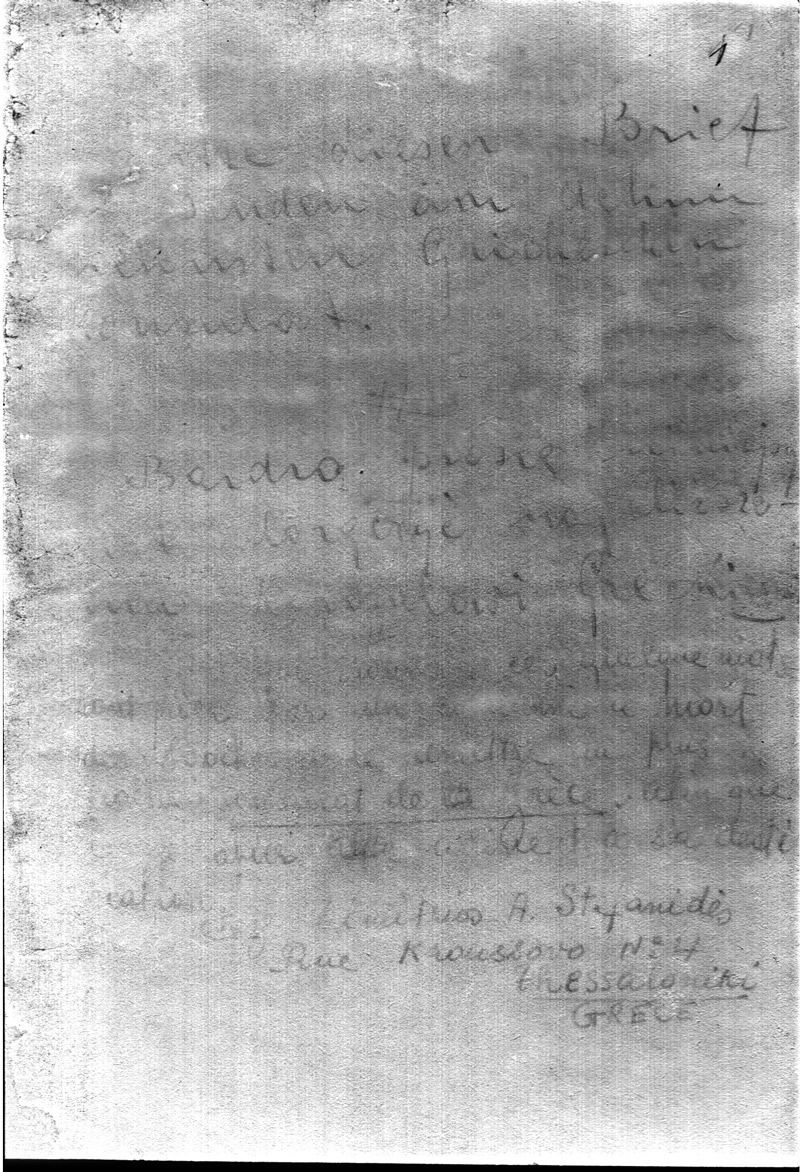 First page result
First page resultAs a result, each page of the manuscript underwent such processing. If out of 12 original sheets, 11 scans were 100% unreadable, then after processing, readable fragments were designated on all sheets.
 Processing result
Processing resultAll these pages were sent to Paul, who forwarded them to his colleague Janis (Dr. Ioannis Karras) at the University of Freiburg, a native speaker of the modern Greek language and historian. He had been waiting for them for a long time and was preparing for the start of the translation into English. He also contacted through his channels the Jewish community in Thessaloniki. Reached the daughter Nelly, although it was not a secret, she works in Athens at the Israeli embassy. We connected more translators. If you are familiar with linguistics, you should understand how a language can change in 70 years. There are many borrowings from other languages in the text. Many moments without an understanding of the context of history and other events of that time may be completely incomprehensible.
According to the first translations in Thessaloniki, confusion began as new names surfaced and everyone began to look for new family ties. The book about the father in the hands of Nelly with new materials. Thessaloniki. Greece.
The book about the father in the hands of Nelly with new materials. Thessaloniki. Greece.Well, now the result of the translation:
— [] , , .
, , , , , , «», .
2 1944- , «», […] , — , .
[ ] […].
, , [] […] [ ] […]
, , , - .
, 11 , . . , — ? , ? , , .
15 . [] . , , — , , 3000, , . 6–7 .
, , -, . […], [] , , . […] , . […] […] , [ . .]. , , . - , , , […] [] [] .
[…] […] , , . , , [] , , . . , . , . , , , — , . [ ], , , . . , , 600 000 , , , , 10 000 . , , , , . , , , . , ?
. , , . , 1000 , 200 , . 800, . — .
, , . — 26 , . , , , , , , . , , , .
, , , : — , , , ? , , ?
[ ] . , . , , ?
, , , , , , ! [ ] ( , , ? , , , ).
— .
, , , — , . — , , , . , , , , , , , .
, . , , 12 1944 . - , , , .
, , , .
.
, , , , , .
, - , , , , . !
?
, , , , . .
, , , ? - , .
, , [] .
: !
.
, . , , , , , , , . […] 300 . [ ] , , , .
1 400 000.
, ! , , , : . , № 9 .
, :
Dimitrus Athanasius Stefanidis
st.Cruzova 4, Thessaloniki, Greece.
This is my last will.
I am doomed to death by the Germans, because I am of the Jewish religion.
With thanks, M. Najari.
The text with detailed footnotes can be found in the new newspaper.
.
The English version is published here .Our lecture at the Museum of Tolerance:The process itselfHowever, the story with the translation of the manuscript is not completed. This is page 11 (number 12 in the corner is a museum archivist's mistake), which is hard to read. If you are familiar with modern Greek, then any detail will be of benefit. Whilst here to parse the date 11/03/44, after the first paragraph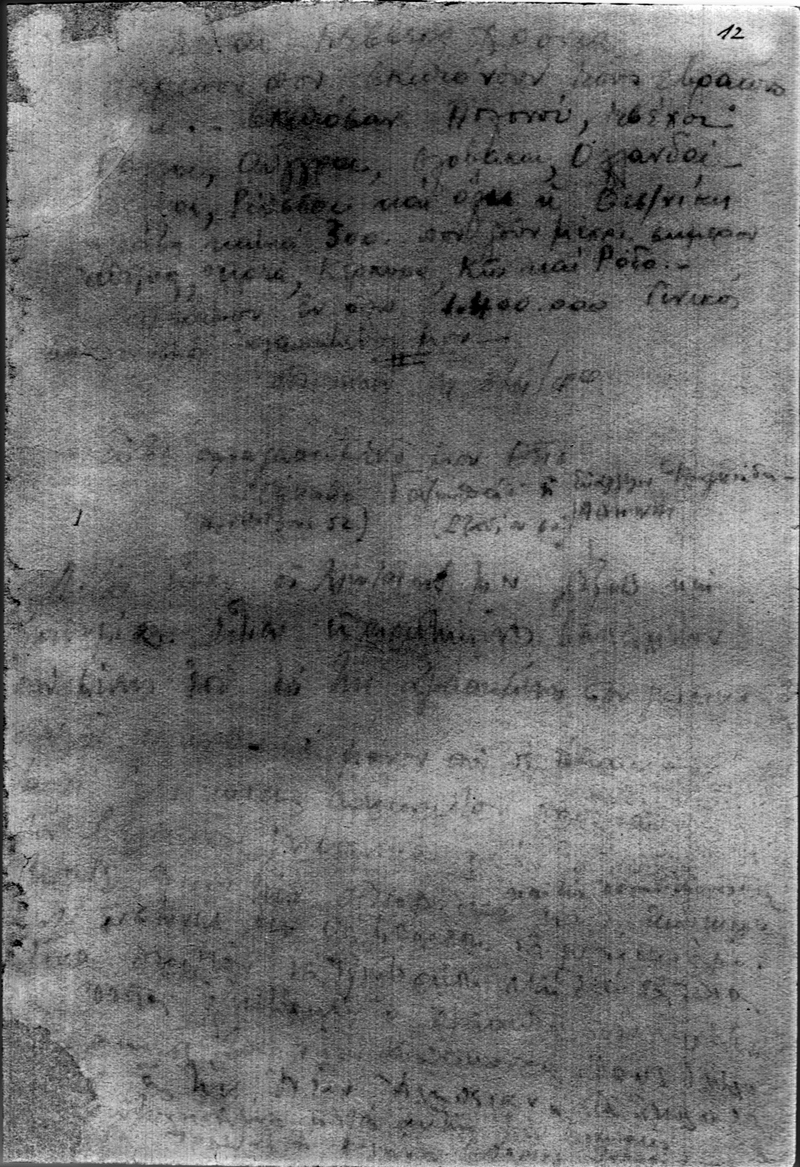 where the source yadi.sk/d/XaAg8nyM3YNtLkHere the original files yadi.sk/d/DL9slb3I3aTLCgIf you have any linguists familiar, I'm sure a few words anyone can understand.I want to say thank you BarsMonster for technical advice on the operation of multispectral equipment.Information about the life of Marseille here: lechaim.ru/academy/marsel-nadzhari
where the source yadi.sk/d/XaAg8nyM3YNtLkHere the original files yadi.sk/d/DL9slb3I3aTLCgIf you have any linguists familiar, I'm sure a few words anyone can understand.I want to say thank you BarsMonster for technical advice on the operation of multispectral equipment.Information about the life of Marseille here: lechaim.ru/academy/marsel-nadzhari